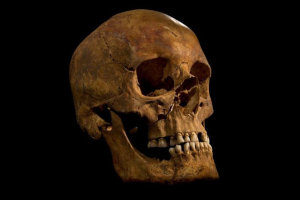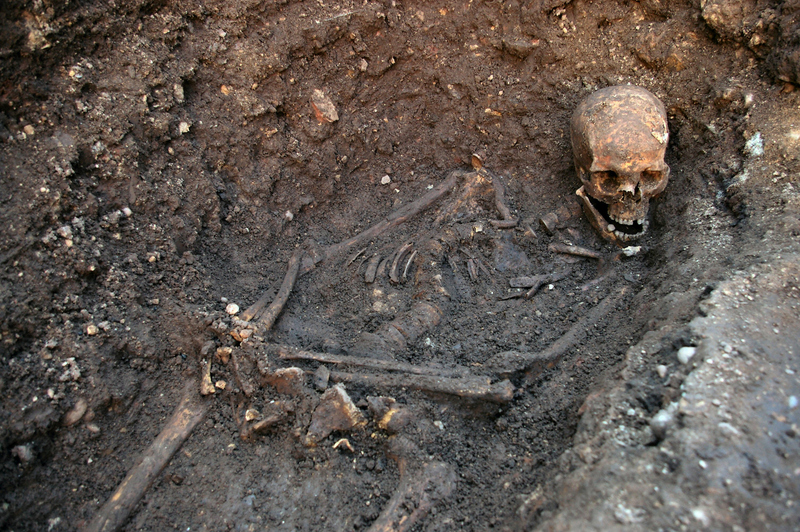
It is confirmed: King Richard III, whose remains were identified and exhumed in September, 2012 near Leicester, England, led a royal lifestyle, particularly during his last few years as King. A recent bone chemistry study completed by a joint scientific team from the British Geological Survey and the University of Leicester backs it up with evidence. This might seem to be a rather unnecessary confirmation for a common assumption—kings lived like, well, kings. But the same study has also revealed evidence of previously unknown changes in diet and location during his youth.
_________________________________
The remains of King Richard III found in Trench 1 during the Leicester excavations. Photo Credit: University of Leicester
_________________________________
Led by Angela Lamb, Isotope Geochemist with the British Geological Survey, the research team took bone and tooth enamel measurements of strontium, nitrogen, oxygen, carbon and lead from the teeth, a femur and a rib as they developed and rebuilt at different stages related to geographical location, pollution and diet through time during the king’s life—somewhat analagous to dendrochronologists examining the tree rings in samples of wood to determine the changes in the environment and growth patterns of a tree in other archaeological studies.
They found that the teeth showed that he had moved from Fotheringay castle in eastern England by the time he was seven years old. Findings also suggested that during this time he was in an area of higher rainfall, older rocks and with a changed diet relative to his place of birth in Northamptonshire. Results from examining the femur showed that he moved back to eastern England as an adolescent or young adult, with a diet that was consistent with that typical of the high aristocracy. Data from the rib indicated the greatest change in diet, while he was King, showing an increase in consumption of freshwater fish and birds, such as swam, crane, egret and heron, popular items on the menu of royal banquets during his lifetime. Moreover, the bone chemistry analysis suggests he was drinking increased amounts of wine during his reign as King, supporting the notion that food and drink correlated with social status in Medieval England.
“The chemistry of Richard III’s teeth and bones reveal changes in his geographical movements, diet and social status throughout his life,” said Lamb.
Richard Buckley, who was the lead archaeologist on the excavations conducted by the University of Leicester Archaeological Services, said, “This cutting edge research has provided a unique opportunity to shed new light on the diet and environment of a major historical figure –Richard III. It is very rare indeed in archaeology to be able to identify a named individual with precise dates and a documented life. This has enabled the stable-isotope analysis to show how his environment changed at different times in his life and, perhaps most significantly, identified marked changes in his diet when he became king in 1483.”
Read about the most fascinating discoveries with a premium subscription to Popular Archaeology Magazine. Find out what Popular Archaeology Magazine is all about. AND MORE:
On the go? Get the smartphone version of Popular Archaeology as an app or as an ebook.
Popular Archaeology’s annual Discovery Edition eBook is a selection of the best stories published in Popular Archaeology Magazine in past issues, with an emphasis on some of the most significant, groundbreaking, or fascinating discoveries in the fields of archaeology and paleoanthropology and related fields. At least some of the articles have been updated or revised specifically for the Discovery edition. We can confidently say that there is no other single issue of an archaeology-related magazine, paper print or online, that contains as much major feature article content as this one. The latest issue, volume 2, has just been released. Go to the Discovery edition page for more information.








